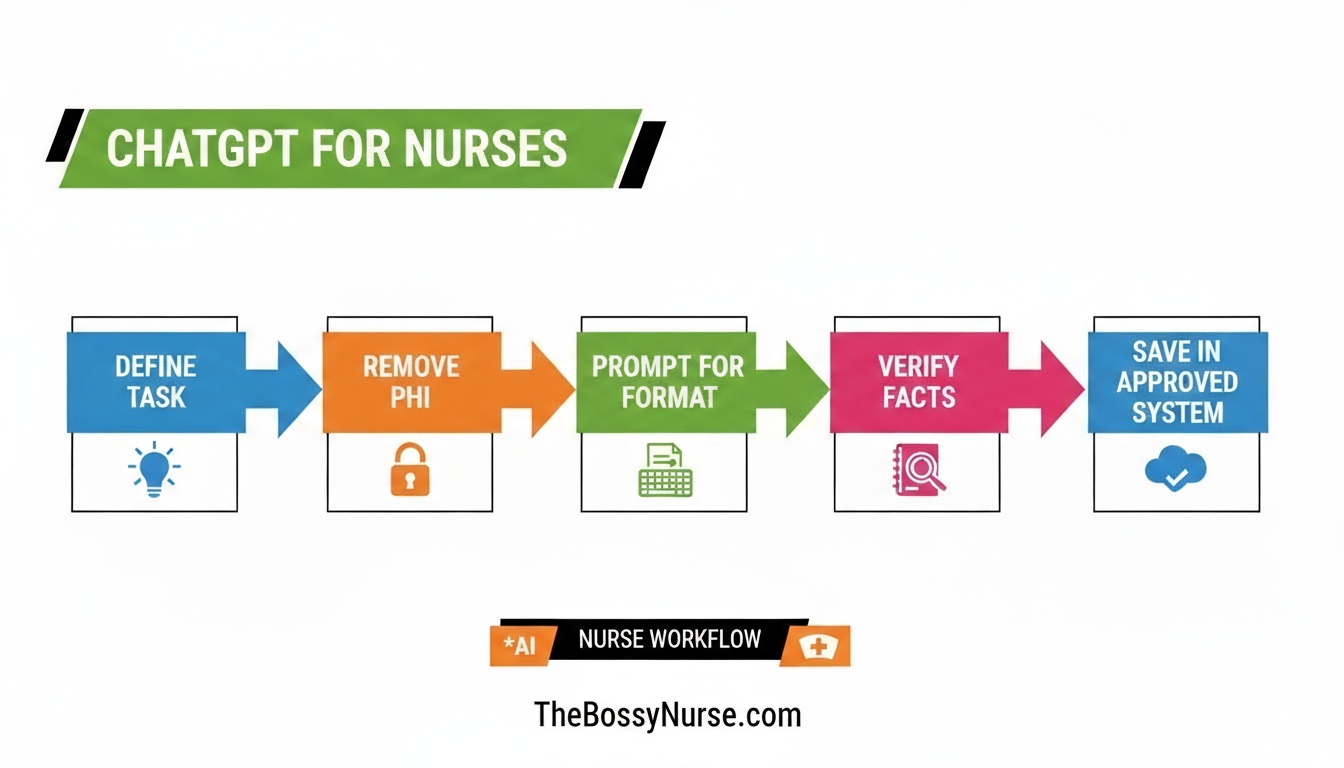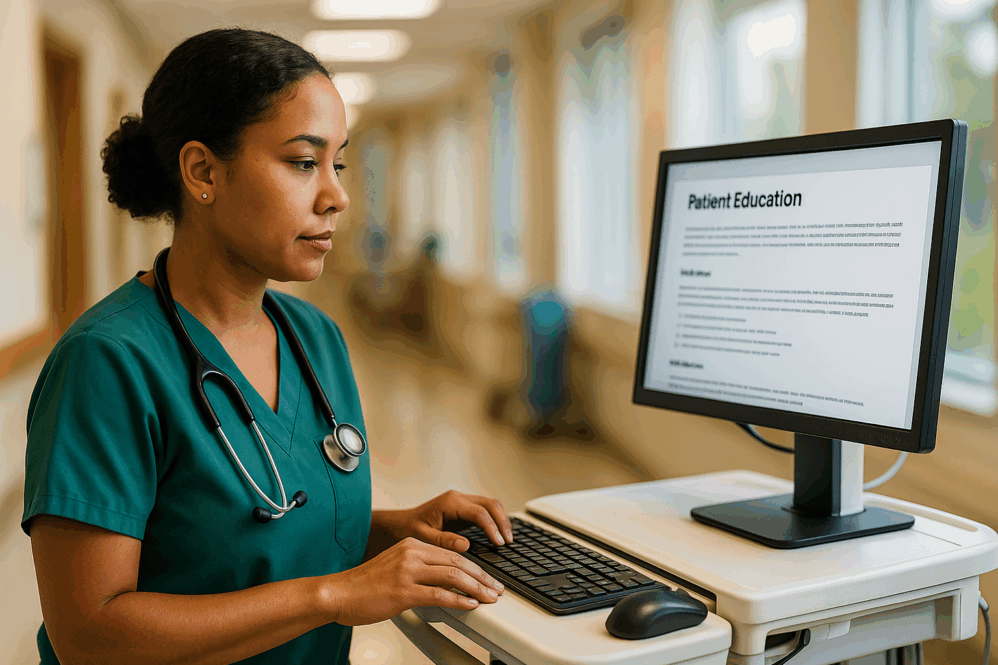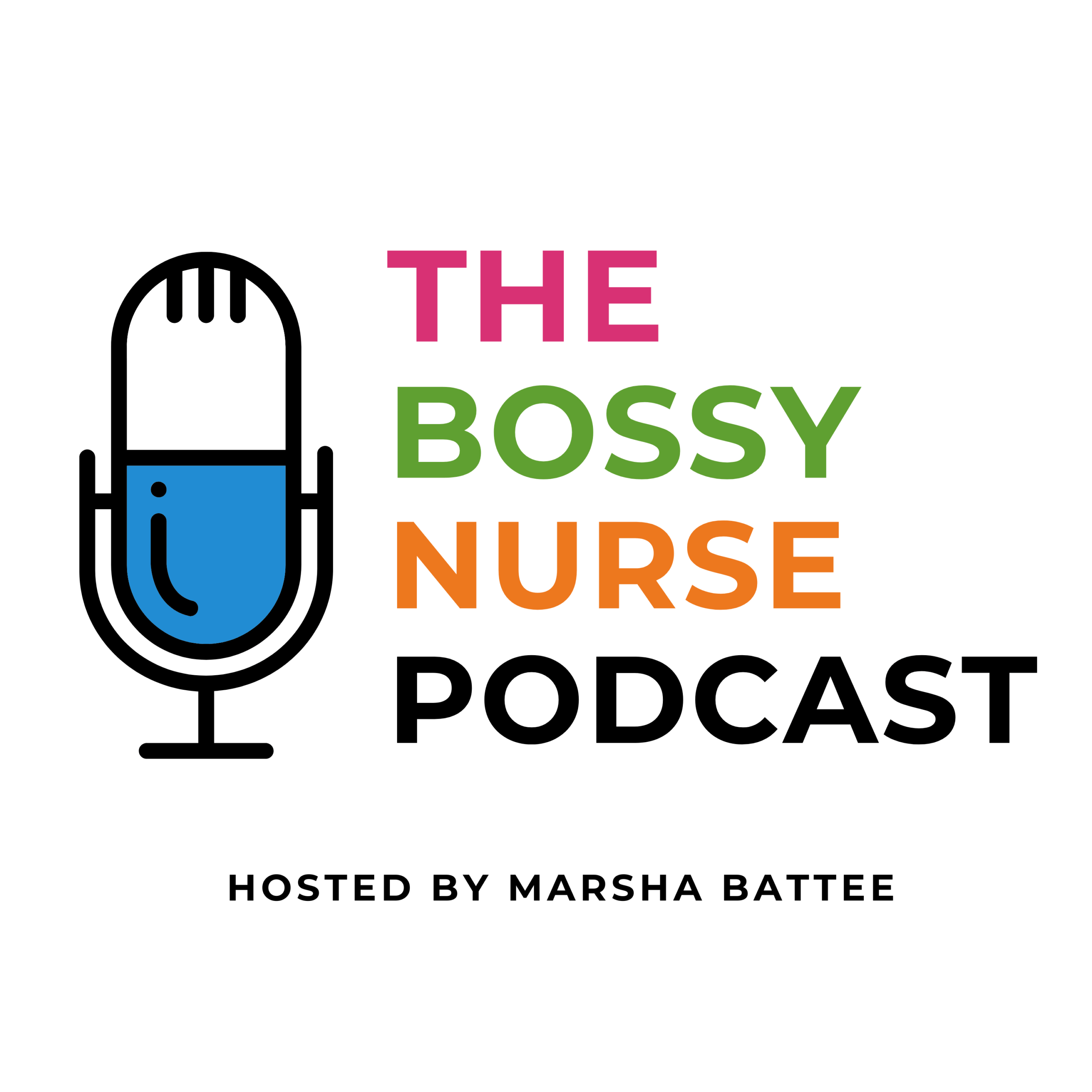This article is part of the AI for Nurses Series at TheBossyNurse.com.
Intro
This article shows nurses how to they can use ChatGPT for everyday personal tasks and work without risking privacy. ChatGPT is an Artificial Intelligence assistant that turns your plain-language prompts into drafts, lists, summaries, and step-by-step plans.
How I use ChatGPT
Below, you’ll find examples of how I use ChatGPT today.
- Custom Automation: I create custom GPTs that automate tasks for me, like research, data pulls, and drafting content from templates I’ve created. Outcome: less time working on mundane tasks.
- Blog content ideation from existing posts: I ask ChatGPT for topic ideas clustered by theme using links or excerpts from my prior articles. Outcome: vetted editorial calendar starters.
- Podcast support: I have it generate episode outlines, guest briefs from website searches, and show notes from a transcript. Outcome: tighter structure and faster production.
- Deep-dive research prep: I request plain-language explanations, pros/cons, and key terms for complex topics. Outcome: quicker ramp-up and better follow-up reading.
- Website analysis and marketing reframes: I have it audit page copy (aka “content”) for clarity and calls-to-action, then rewrite headlines and blurbs for specific audiences. Outcome: clearer messaging and higher conversion experiments.
Key takeaways in the article
- Start with de-identified data only.
- Ask for formats you need: checklist, script, bullets.
- Verify every clinical statement against trusted sources.
- Save reusable prompts as templates for speed.
What is ChatGPT?
ChatGPT is a conversational AI tool that generates text based on your prompts. You give it instructions and context; it returns drafts, summaries, outlines, and stepwise procedures you can refine.
Inputs are plain language. Outputs are text you edit for accuracy and fit.
For AI + nursing best practices, see AI Series here on TheBossyNurse.com.
Why ChatGPT matters for nurses
For nurses working across bedside, ambulatory, education, research, leadership, and entrepreneurship, time is scarce. ChatGPT compresses first-draft time so you can focus on clinical judgment, teaching, and quality.
Applications
- Convert clinical guidelines you already know into concise bedside checklists.
- Draft patient-friendly education, then validate and localize (Use an organization-approved AI tool where required and check what resource tools you already have available).
- Summarize research and extract implications for QI projects.
- Build agendas, run-of-show scripts, and follow-up emails for leadership tasks.
- Turn program ideas into lean canvases and marketing blurbs for nurse-led ventures or projects.
- Policy check: Always follow your organization’s policies and procedures for AI use and PHI.
How ChatGPT differs from other AI options
Breadth and flexibility: Handles many formats in one chat (checklists, scripts, lesson plans) with strong follow-up refinement.
Prompt tolerance: Works well with natural, imperfect prompts; easy learning curve.
Ecosystem: Widely adopted, with many examples and templates nurses can adapt.
Cost/tiers: Free entry; paid tiers unlock higher limits concerning advanced features, prompts and models (mini vs. thinking vs. pro– based on speed of the search and depth of the search).
Accuracy caveat: Excellent at structure and clarity; clinical facts still require verification.

Misconceptions and corrections
- “I can paste PHI safely.” Do not input PHI unless your employer provides an approved, compliant pathway (use your organization’s vetted AI tool).
- “AI replaces nursing judgment.” It drafts text; you apply clinical reasoning and policy.
- “If it sounds confident, it’s correct.” ChatGPT can be wrong. ALOT… It’s still learning. Please verify claims against guidelines and references.
- “One prompt is enough.” Iteration improves results; ask for format, tone, specifics, and clarification.
Alternatives to try
- Google Gemini: Pick when you need strong Workspace integration. Side panels in Docs/Sheets/Gmail for drafting, analysis, and “Gems” assistants; good when you live in Google’s stack.
- Claude.ai: Pick when you want long, readable outputs and strong summarization of lengthy documents with a gentle learning curve.
- Microsoft Copilot: Pick when you work in Microsoft 365 and want AI inside Word, Excel, PowerPoint, Outlook, and Teams with file-aware assistance.
FAQ
What is ChatGPT and how does it work?
It is a conversational AI that turns your instructions into drafts and summaries. You provide context and goals; it returns structured text or images that you can edit (with additional prompting) and verify.
How can nurses use ChatGPT safely within policy?
Use only de-identified information. Do not paste PHI. Work on approved devices and networks. Save outputs in approved systems. Confirm content against clinical references and your organization’s policies.
Is ChatGPT HIPAA compliant?
Assume no by default. Only use a version your organization has approved via a business agreement and documented workflow.
Can ChatGPT write patient education I can hand out directly?
It can draft clear, fifth-grade-level text. You must validate accuracy, align with local protocols, and add clinic-specific instructions.
How do I prompt ChatGPT effectively?
State the role, audience, format, reading level, and constraints. Example: “Create a one-page fall-prevention checklist for bedside RNs. Fifth-grade reading level. Bullets only.”
Conclusion
ChatGPT saves drafting time for education, policy translation, research summaries, leadership communications, and in my case, content for websites and podcasts. Use it to structure work, then apply nursing judgment and policy.
This article is part of the AI for Nurses Series at TheBossyNurse.com. Have a question about helpful uses for ChatGPT? Drop your question in the comments below!








